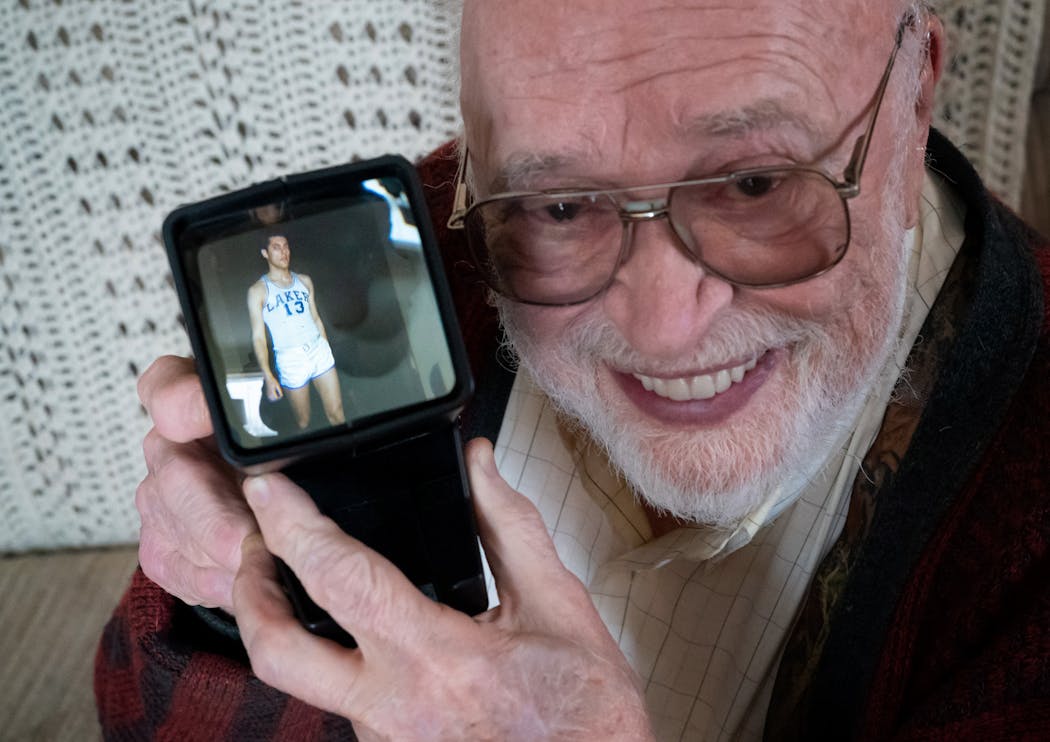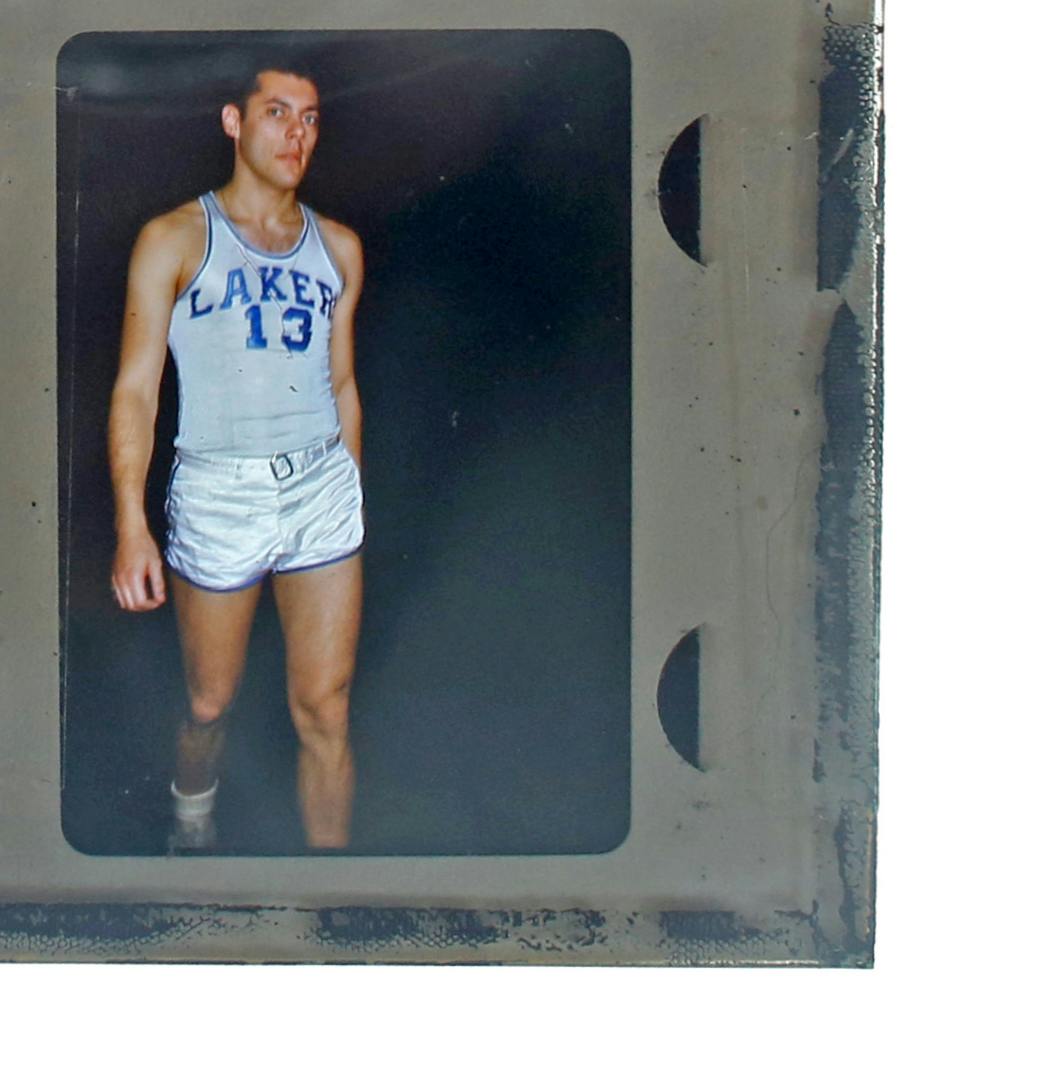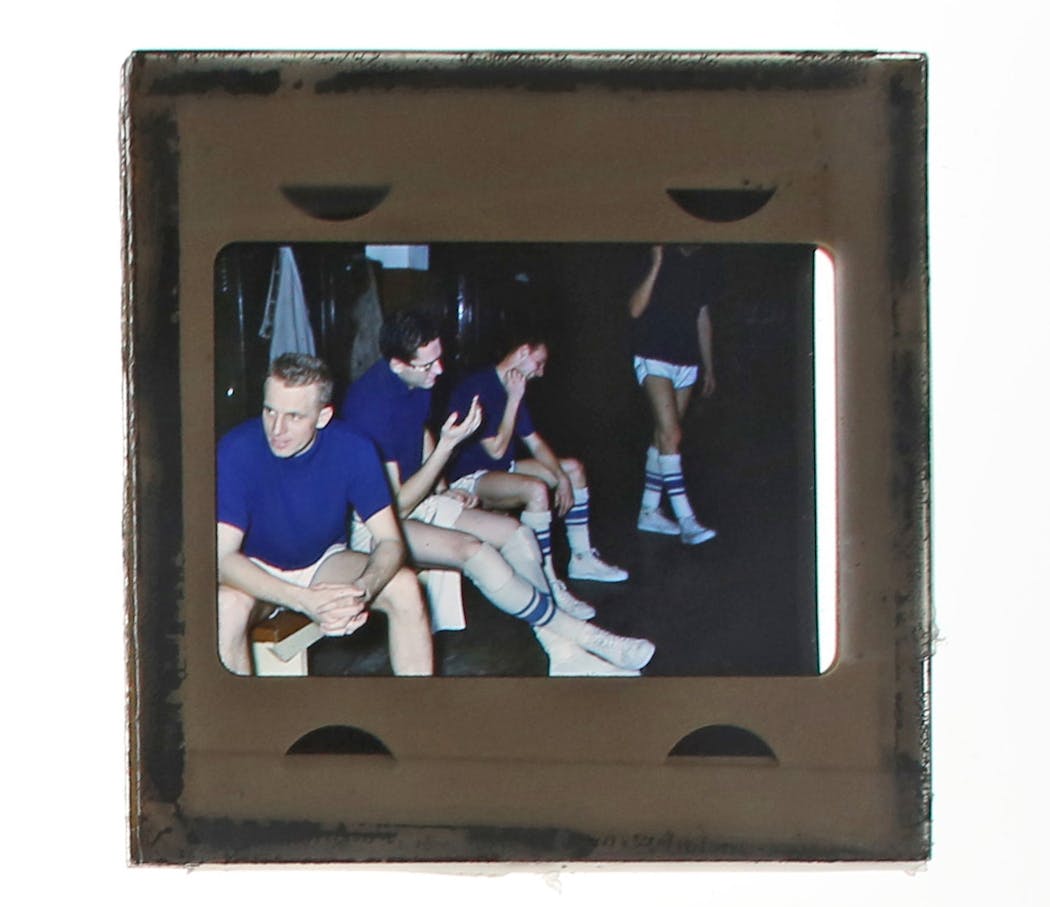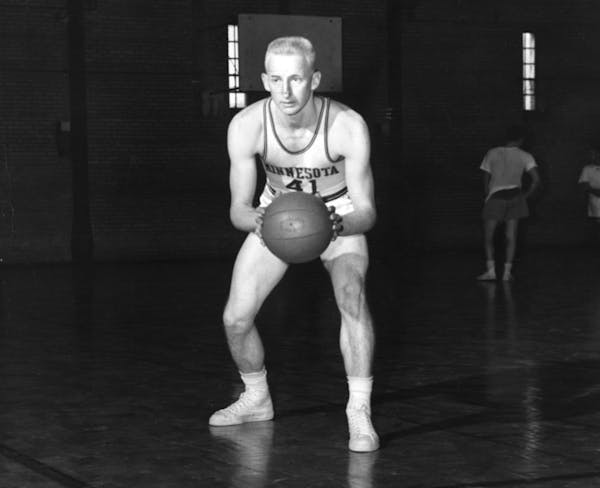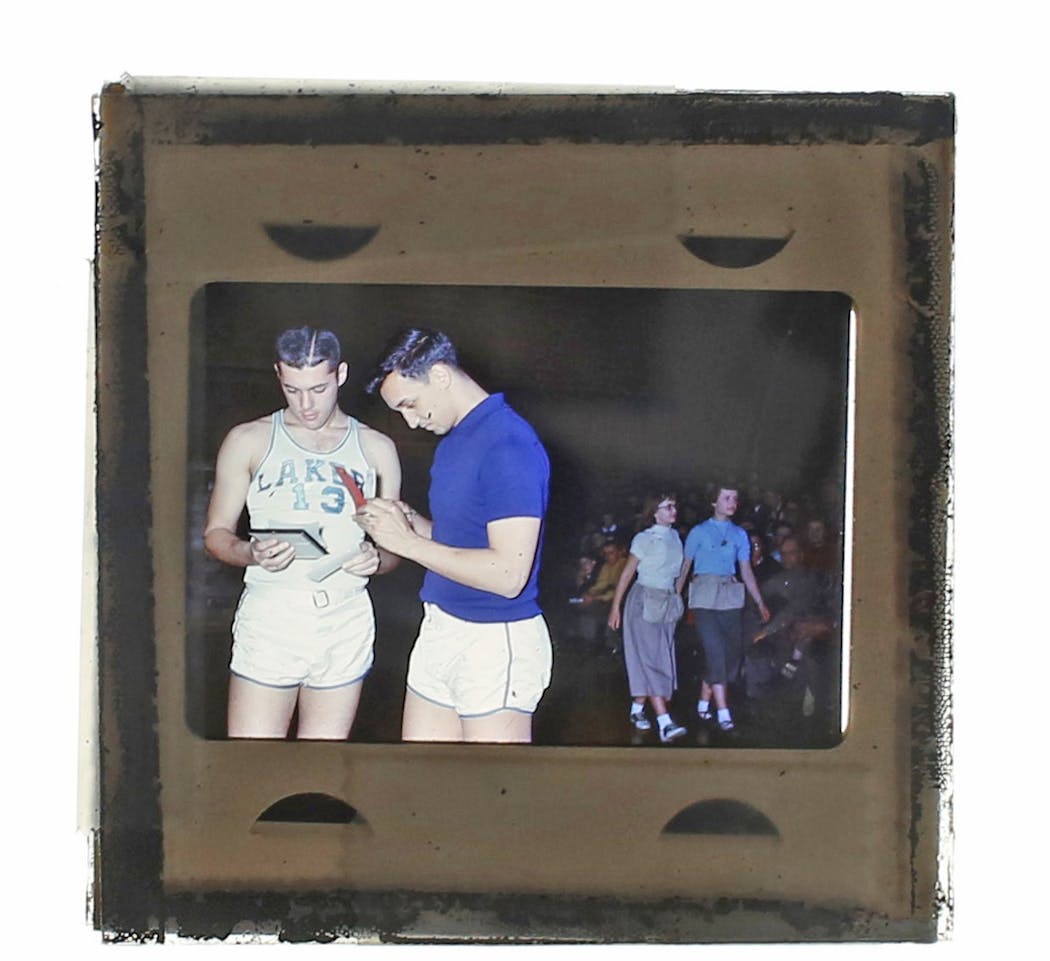HIBBING, MINN. – When John Peterson pulled the dusty, battered case from his basement, it was the nearest thing to buried treasure any of us is likely to see.
Ever since his wife's death almost two years ago, the 81-year-old Peterson had been going through their belongings, sifting and sorting and rearranging.
One of his tasks was bringing some order to more than 6,000 uncataloged slides from his 60-plus years as a professional photographer.
For months, he worked his way through them. A box here, a tray there. Another box. And another. Squinting through a small glass viewfinder, holding the slides up to the light one by one.
Finally, all that remained was the scarred brown case he hadn't looked at in decades.
And when he opened the lid, what he found amazed him.
There, in vivid color, were his heroes.
Looking back at Peterson through the glass were basketball players from a prehistoric age: young, powerful, confident.
Like summoning a genie from a bottle, Peterson had brought forth a wondrous world that few alive can remember.
It was a time when the NBA was young, when major league basketball was played in such cities as Fort Wayne, Ind., and Davenport, Iowa.
A time when fans were closer to the players, when even solid stars were regular Joes who had to work in the offseason to make ends meet.
So perhaps it's not surpris-ing that a gawky, 13-year-old shutterbug could wander into the locker room of the world champion Minneapolis Lakers with his camera — and instead of being tossed out on his ear, be adopted as a sort of team mascot, hanging around through his high school years and taking courtside pictures at dozens of games with the NBA's first dynasty.
But when Peterson thinks about it now, he can only shake his head in amazement.
"The more I thought about it, the more I thought, 'Somebody's got to know about this,' " he said, perched on a sofa in his tidy living room in this Iron Range city. "That would never happen today. The whole thing was so different from today.
"These days, if a kid went into the locker room, they'd put him in jail."
'Boys, this is Petey'
Growing up in Montevideo, Minn., Peterson loved photography and loved Lakers basketball.
He bought photos of the Lakers players and took them to the local furniture store for framing, then hung them on the wall of his bedroom.
He and his grandfather, Marius Peterson, used to huddle around the radio and listen to Dick Enroth call the games on WCCO.
One day — it was late 1950 or early 1951 — his grandfather said, "Why don't we go to a game?" Grandpa Marius had retired as a bridge foreman on the Milwaukee Road railroad, and he had a golden pass that let him ride for free.
They took the train to Minneapolis and got a room at the Hotel Vendome, a fleabag in the notorious Gateway District. That night, they walked the mile or so across downtown to the Minneapolis Auditorium, home of the NBA champs.
Peterson brought his Kodak Retina 280, an early 35-millimeter camera that was a fancy piece of gear for a teenage boy.
"I saw the sign that said 'locker room,' " Peterson recalled. "I said, 'Grandpa, why don't you go to the seats? I want to walk around.' "
Peterson knocked on the door, and it was answered by Lakers guard Bob Harrison. Peterson introduced himself and asked if he could take some pictures.
Harrison threw his arm around the teen's shoulder and ushered him in.
"Boys, this is Petey," he announced.
Peterson snapped photos as the players dressed for the game. Then, he said, "They took me out and put me under the basket and said, 'Sit here and take some pictures.' "
For the next four years, until he graduated from high school, Peterson rode the train to dozens of Lakers games and took hundreds of photos. When he got to town, he'd hang around the team offices at the old Loeb Arcade on Hennepin Avenue, and sometimes a player passing through would take him out for a hamburger and a milkshake.
The players treated him like a member of the family, he said.
Once, an usher tried to shoo him away from courtside. Lakers center George Mikan, the undisputed king of the early NBA, came over, all 6-10 of him.
"He tapped the usher on the shoulder and said, 'He stays — you go,' " Peterson said with a laugh.
Some great Lakers remember
Peterson's not the only one thrilled by the memories in the brown case. Several of the old Lakers were delighted to talk about their playing days, men in their 90s coming to life as they recalled their youth.
"Nobody ever asks me about basketball!" exclaimed Bud Grant, 91, a rugged Lakers forward who's better known for his NFL Hall of Fame coaching career with the Vikings. "Oh, I haven't thought of those names in 70 years."
"I had a great experience with the Lakers," he said. "To play with all the great players I did — we had a good group.
"We didn't make a lot of money, but it was a lot of fun."
Grant remembers his first Lakers game, in 1949. He joined the team at midseason, fresh out of the University of Minnesota, for a night game on Christmas Day. Unfortunately, his Christmas dinner didn't agree with him, and he showed up at the arena feeling sick.
He told coach John Kundla that he'd suit up but he wasn't sure he could play. The crowd had other ideas.
"They get almost to halftime and the crowd is chanting, 'We want Grant! We want Grant!' " he recalled.
He went into the game and didn't touch the ball until there were 10 seconds left in the half.
"I threw up a shot that went in, and the roof about came off the place," he said with a chuckle.
Grant doesn't remember the young photographer: "You know how long ago that was?" he said. Harrison, who welcomed the kid into the locker room that first day, does remember him.
"I do, but I can't really tell you anything else," he said. At 91, Harrison is retired from a career that included coaching at Harvard and Kenyon College before going on to become CEO of a manufacturing company.
Now living in Florida, he spoke with animation about his Lakers days, and his description of the team chemistry sounds very much like the way Peterson describes it.
"The Lakers were like a family. That was one of the great things," Harrison said. "I loved everything about Minneapolis. The people were wonderful, and they certainly supported us."
Harrison isn't surprised that the team would treat kindly a youngster who wandered into its midst.
"All of us felt like, the people who came to see us play, we had a responsibility to them, because they were providing us with our salaries," he said. "So we were always good about talking to people, giving them autographs, going to their schools.
"We did all those things for the kids. I think we did an amazing job, actually."
Whitey Skoog, 92, a nifty guard who pioneered the jump shot, retired after a legendary coaching career — in golf, not basketball — at Gustavus Adolphus in St. Peter, Minn., where he died Thursday morning..
"That was about the time basketball was becoming an entity," Skoog said in an interview last month, muscling its way onto the pro sports scene, though its real arrival was well in the future.
"It was strange for me," he said. "I came from a Norwegian family, and they didn't think much of paying somebody to play with a little round ball."
Was it fun, or was it more like a job? he was asked. Skoog smiled.
"I'd like to have had that job the rest of my life," he answered.
'All because of the Lakers'
Peterson graduated from high school in 1955 and went to work in a Montevideo photo studio. He eventually bought out the owner and ran it for more than 20 years. Later, he moved to Hibbing and bought a studio that he still runs part-time.
The Lakers, meanwhile, fell on hard times as their stars aged and retired. The team that won five NBA titles in six years now ran up a string of five straight sub-.500 finishes. In April 1960, owner Bob Short announced he was moving the team to Los Angeles.
Peterson had gone in another direction, too. Now a busy professional, he didn't have time to make the trek into the Cities for games. The last game he attended was a preseason exhibition in 1959, featuring young Lakers star Elgin Baylor, who played two seasons in Minneapolis before completing a Hall of Fame career on the West Coast.
"It was a part of my life, but then I moved on," Peterson said.
But what a part.
"It was because of that time that I became a photographer and had the success that I've had," he said. "It's all because of the Minneapolis Lakers."
Olympic organizers unveil strategy for using artificial intelligence in sports
Former Cooper football star Howard transfers from LSU to Gophers
Chinese Grand Prix could deliver drama to F1 and slow Verstappen's victory march

